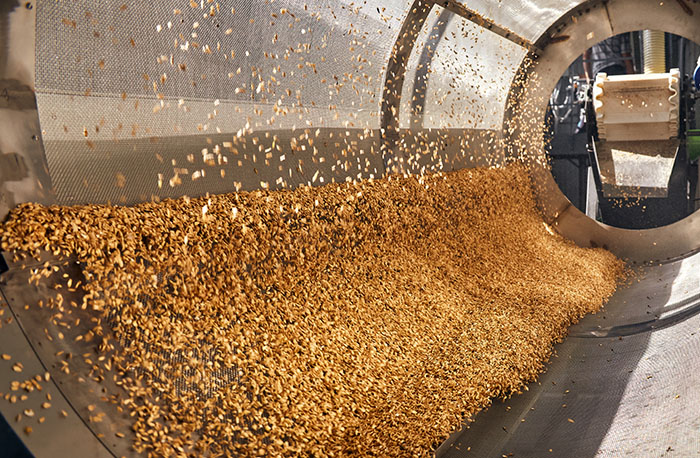
Do you know the differences between roller mills and hammer mills? Are you looking to use these machines in your business but aren't certain which one is the right choice?
At their core, both of these milling machines are similar in that they grind down particles and feed material to a desired size. However, there are key differences between the two that make them unique from one another. To help you make the right decision, we've put together an easy guide that'll teach you the main pros and cons of each grinding machine. Keep reading to learn everything you need to know!
Grinding Process
These milling machines may have a similar function, buttheir structuresare very different from one another.
A hammer mill contains a drum in which many little hammers are attached to the inside. As the material goes through the mill, the hammers collide with the material. The force of this collision breaks the material down until it reaches the desired size and passes through a screen.
A roller mill uses a more controlled mechanism. Grooved cylinders compress and roll the material until it breaks apart. It keeps going until the material is the exact size that you need. These grooved cylinders come in many different shapes and sizes, and it's easy to add or subtract the number of grooves in the machine as needed.
Uses and Applications
由于碰撞分裂的使用费用d and other material, hammer mills have a wide variety of uses. They're capable of grinding down any type of material or feed, including fibrous materials. Hammer mills have no trouble breaking down large materials since the hammers have such a large range of motion within the machine. They're great if you want to create mashes or flours with your material.
Roller mills, on the other hand, can't handle larger materials since those particles are unable to fit between the cylinders. You'll need to break the material down beforehand to get it to fit inside the machine. Roller mills are exceptional at grinding many types of particles but cannot break down fibrous materials. The motion of the cylinders causes the fibers to get caught in the grooves of the machine.
铣削的结果
The biggest difference between these two machines is theresulting feedor ground material.
Hammer mills are a less precise machine since the hammers swing into the material. It's not possible to make the material the same shape and size with every impact. This gives you a varied result, which isn't a good choice if you're trying to follow a certain regulation or standard. However, hammer mills can give you very fine results, since the hammers can keep hitting the material until it's crushed into a fine powder. Roller mills can only go as fine as the grooves in the cylinders allow.
Hammer mills create a lot of dust from the impact of the hammers on the material. This also produces a lot of heat, which means workers will need to be careful and take proper safety precautions while using the machine.
One of the biggest benefits of roller mills is their capability of creating uniform particles. The roller cylinders are a precise mechanism that gives you the exact same size of particles with every motion. This makes it the perfect choice if you need to grind things such as coffee that require precise measurements for each particle.
A roller mill produces far less heat and dust compared to a hammer mill. The grooves of a roller cylinder can be switched out to suit your needs depending on the material. Hammer mills don't have this kind of customization.
Milling Capacity
One of the best benefits of hammer mills is the amount of material they're able to process at one time. Their drum capacity allows them to grind down large quantities of material without any trouble.
Roller mills have a smaller capacity since the cylinders have less space between them for the material to fit. It'll take more time to process the same amount of material in a roller mill compared to a hammer mill.
Product Separation
A hammer mill is great at processing large amounts of material but it has no capability of separating the material during the grinding process. This makes it difficult for businesses that need to separate certain parts of the material. The ground materials all go through the same extraction process and gather as one product in the end.
Roller mills are a perfect choice if you need to separate your product. It's easier for the rolling mechanism to move the material through a mesh that catches and separates the material during the process.
Initial Cost
When it comes to the cost battle ofroller mills vs hammer mills, hammer mills are the clear winner. They're much cheaper to install when compared to roller mills.
This makes hammer mills a better choice for companies that have a strict budget, but sometimes roller mills are worth the extra startup cost.
Maintenance and Upkeep
Hammer mills are simpler machines which means that they often require far less maintenance and upkeep toremain safeand functioning. They do need more power to run, and the excess heat produced during the grinding process can cause performance problems.
Roller mills are a more complicated type of machine and require much more maintenance to stay at peak performance. However, these machines don't use up as much power and they produce less heat.
Choosing Between Roller Mills and Hammer Mills Takes Careful Consideration
There are many pros and cons to both roller mills and hammer mills. Now that you've read through our guide, it'll be easier to decide which type of mill your company needs. Take the time to weigh all of the benefits until you figure out which one suits your business best.
Still uncertain which mill is right for your business needs? We're here to help!Contact ustoday and we'll guide you towards the best grinding machine that'll match your business needs.



